#st catherine's island
Text




─ •✧ WILLIAM'S YEAR IN REVIEW : SEPTEMBER ✧• ─
7 SEPTEMBER - William visited Pret a Manger in Bournemouth. Afterwards he was received on arrival by His Majesty's Lord-Lieutenant of Dorset (Mr. Angus Campbell) AFC Bournemouth.
8 SEPTEMBER - William and Catherine undertook engagements in St. David's and were received by His Majesty's Lord-Lieutenant of Dyfed (Ms. Sara Edwards). They attended a Memorial Service for Queen Elizabeth II in St. David's Cathedral and afterwards met members of the local community. Later, they visited Câr-y-Môr Seaweed Farm. Subsequently, they met volunteers from the RNLI at the RNLI St. David's Lifeboat Station. William wrote a letter to Mr. Gear about the memorial of her grandfather who was a WWII veteran.
9 SEPTEMBER - William joined Catherine and Princess Anne for an episode of 'The Good, The Bad and The Rugby' Podcast.
10 SEPTEMBER- William attended the Wales Vs Fiji Rugby World Cup pool match in Bordeaux and was received upon arrival by His Majesty's Ambassador to the French Republic (Dame Menna Rawlings).
13 SEPTEMBER- William was received by Colonel Jane Davis (Vice Lord-Lieutenant of Greater London) as he visited Mates in Mind at a construction site.
14 SEPTEMBER - William and Catherine visited Stirling Lines in Hereford. Afterwards, they were received by Mr. Patrick Wrixon (Deputy Lieutenant of Herefordshire) at Madley Primary School's Forest School. Subsequently, met Members of We Are Farming Minds at Kings Pitt Farm.
18 SEPTEMBER - William departed from Heathrow Airport for USA and was received upon arrival at Newark Liberty International Airport by His Majesty's Consul-General for New York (Ms. Emma Wade-Smith) as he kicked off his Trip to New York. He visited the Billion Oyster Project at Governor's Island and met schoolchildren at the Brooklyn Bridge Park. Afterwards he called upon Mr. António Guterres (Secretary-General of the United Nations) at the UN Headquarters.
19 SEPTEMBER - On his second day in New York, William held and audience with The President of the Republic of Ecuador. Afterwards, he attended the Earthshot Prize Innovation Summit. Later, he visited FDNY Firehouse Ten and was received by His Majesty's Ambassador to the United States of America (Dame Karen Pierce). Finally he attended a Dinner for the Earthshot Prize at Tavern on the Green and later departed NY from John F. Kennedy International Airport for the UK.
20 SEPTEMBER - William arrived at Heathrow Airport, London, from the United States of America.
21 SEPTEMBER - William wrote the Foreword to London Air Ambulance Charity's bereavement booklet.
22 SEPTEMBER - William and Catherine were spotted at Prince George's Football Game.
27 SEPTEMBER- William and Catherine hosted a Charities Forum in London.
28 SEPTEMBER - William and Catherine received Mr. Timothy Cook (Chief Executive Officer, Apple Incorporated) at Windsor Castle.
29 SEPTEMBER - He was received by Mrs. Clare Garrett (Deputy Lieutenant of Wiltshire) as he visited BEST - Be A Better You in Swindon.
#review 2023#review september#year in review : william#year in review : 2023#william review : september#year in review 2023 : september#prince of wales#the prince of wales#princess catherine#prince william#princess kate#princess of wales#the princess of wales#catherine princess of wales#british royal family#british royals#royalty#royals#kate middleton#british royalty#duchess of cambridge#royal#catherine middleton#brf#william prince of wales
19 notes
·
View notes
Text
books read in 2023
january
sweep in peace by ilona andrews
one fell sweep by ilona andrews
a court of mist and fury by sarah j. maas
sweep of the blade by ilona andrews
sweep with me by ilona andrews
my best friend’s exorcism by grady hendrix
kiss her once for me by alison cochrun
the seven husbands of evelyn hugo by taylor jenkins reid
i’m glad my mom died by jennette mccurdy
love and other words by christina lauren
sweep of the heart by ilona andrews
the only living girl on earth by charles yu
witches get stuff done by molly harper
you had me at hola by alexis daria
her vigilante by lillian lark
inconvenient daughter by lauren j. sharkey
anon pls. by deuxmoi
you are eating an orange. you are naked. by sheung-king
legends & lattes by travis baldree
bad vibes only (and other things i bring to the table) by nora mcinerny
signs of cupidity by raven kennedy
bonds of cupidity by raven kennedy
crimes of cupidity by raven kennedy
read: 23
february
exciting times by naoise dolan
sweethand by n.g. peltier
you made a fool of death with your beauty by akwaeke emezi
something wilder by christina lauren
highly suspicious and unfairly cute by talia hibbert
you deserve each other by sarah hogle
this is how you lose the time war by amal el-mohtar and max goldstone
would you rather by allison ashley
read: 8
march
meet me in the margins by melissa ferguson
king of battle and blood by scarlett st. clair
the exotic by hampton sides
river of shadows by karina halle
alone with you in the ether by olivie blake
lovelight farms by b.k. borison
the soulmate equation by christina lauren
before i let go by kennedy ryan
haunting adeline by h.d. carlson
the lies i tell by julie clark
one jump at a time by nathan chen
our wives under the sea by julia armfield
all systems red (the murderbot diaries #1) by martha wells
before the coffee gets cold by toshikazu kawaguchi
read: 14
april
funny you should ask by elissa sussman
make a scene by mimi grace
sweeter than chocolate by lizzie shane
the kiss quotient by helen hoang
my favorite half-night stand by christina lauren
romantic comedy by curtis sittenfeld
icebreaker by a.l. graziadei
the wedding proposal by john swansiger
circling back to you by julie tieu
by the book by amanda sellet
a lady’s guide to mischief and mayhem by manda collins
love in the time of serial killers by alicia thompson
if the shoe fits by julie murphy
whispers of you by catherine cowles
the kiss curse by erin sterling
by the book by jasmine guillory
honey & spice by bolu babalola
one night on the island by josie silver
the bodyguard by katherine center
the reunion by kayla olson
the neighbor favor by kristina forest
crooked kingdom by leigh bardugo
do i know you? by emily wibberley & austin siegemund-broka
just my type by falon ballard
delilah green doesn’t care by ashley herring blake
happy place by emily henry
dating dr. dil by nisha sharma
icebreaker by hannah grace
count your lucky stars by alexandria bellefleur
stone cold fox by rachel koller croft
fake it till you bake it by jamie wesley
read: 31
may
the dead romantics
motherthing by ainslie hogarth
the woman in the library by sulari gentill
artificial condition (the murderbot diaries #2) by martha wells
the last word by taylor adams
you shouldn’t have come here by jeneva rose
read: 6
june
fourth wing (the empyrean #1) by rebecca yarros
the very secret society of irregular witches by sangu mandanna
love, theoretically by ali hazelwood
read: 3
july
the traitor queen (the bridge kingdom #2) by danielle l. jensen
the beast by katee robert
baldur's gate: descent into avernus by by james introcaso et. al
forget me not by julie soto
the wishing game by meg shaffer
read: 5
august
the true love experiment by christina lauren
pachinko by min jin lee
almond by sohn won-pyung, translated by joosun lee
hook, line, and sinker by tessa bailey
read: 4
september
hey, u up? (for a serious relationship): how to turn your booty call into your emergency contact by emily axford & brian murphy
everyone knows your mother is a witch by rivka galchen
fangs by sarah andersen
a room with a view by e.m. forster
juniper bean resorts to murder by gracie ruth mitchell
one's company by ashley hutson
the mysterious affair at styles by agatha christie
solita: a gothic romance by vivien rainn
you, again by kate goldbeck
the undertaking of hart and mercy by megan bannen
my roommate is a vampire by jenna levine
the picture of dorian gray by oscar wilde
the vampires of el norte by isabel cañas
her body and other parties by carmen maria machado
evil eye by etaf rum
the seven year slip by ashley poston
read: 17
october
keeper of enchanted rooms by charlie n. holmberg
the serpent and the wings of night by carissa broadbent
shy by max porter
down comes the night by allison saft
the unfortunate side effects of heartbreak and magic by breanne randall
the hurricane wars by thea guanzon
read: 6
november
a witch's guide to fake dating a demon by sarah hawley
the wake-up call by beth o'leary
when in rome by sarah adams
the view was exhausting by mikaella clements and onjuli datta
hello stranger by katherine center
practice makes perfect by sarah adams
do your worst by rosie danan
read: 7
december
bookshops & bonedust by travis baldree
the fake mate by lana ferguson
read: 2
final count: 127/100
#kate’s reading log#read in 2023*#a little late but i wanted to get this up here !!#i’ll update as i go so if you don’t want to see this just blacklist kate’s reading log :)#we hit character limit so i had to reformat lol
106 notes
·
View notes
Text
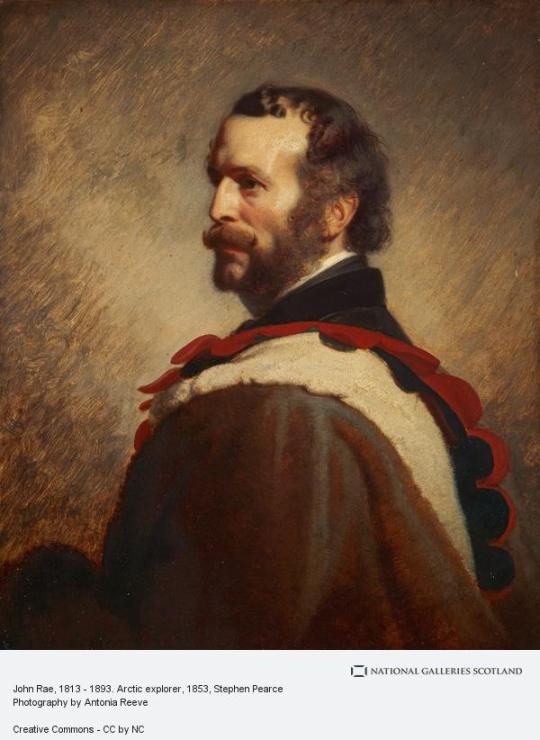
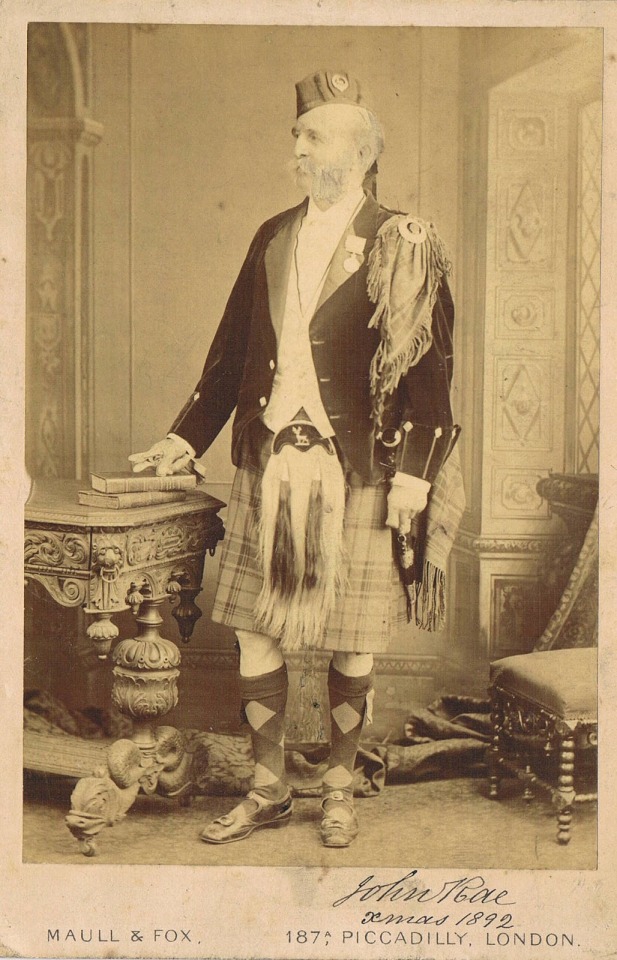


The surgeon and explorer John Rae was born on 30th September 1813 at the Hall o'Clestrain in Orphir on Orkney Islands.
Orkneyjar, a great site I use for sourcing information on the islands states that “John Rae is undoubtedly one of Orkney’s greatest unsung heroes.” and who am I to argue, they also point out that although his memorial is prominent in St Magnus Cathedral, few Orcadians, and indeed Scots in general, have heard of him.
John Rae was the son of John, factor on Sir William Honeyman's estate, and his wife Margaret (Glen). His father was appointed Orkney agent for the Hudson's Bay Company.
After qualifying in Edinburgh as a surgeon young John served on a Hudson's Bay vessel travelling to Canada. Ice forced him to stay over winter there and he loved the area and the wild type of life so much he remained as surgeon at the Moose Factory post on Hudson Bay.
He studied the ways of the local Cree Indians, gathering knowledge and skills from them. The Inuit called him "Aglooka" as he was the best snowshoe walker of his time. In 1849 he took over the Mackenzie river district at Fort Simpson and charted unknown territories on the north Canadian coast. He succeeded in proving the existence of a North West passage (a navigable route across the Arctic from the Atlantic to the Pacific) and searched for the lost Franklin expedition, who were also searching for the passage. Information from the Inuit given to Rae showed that Franklin's men had all perished and the bodies showed signs of cannibalism.
Of course his report made him very unpopular, author Charles Dickens published articles rejecting Rae’s conclusions and the manner in which he had reached them. According to Dickens, it was unthinkable that the English Navy "would or could in any extremity of hunger, alleviate that pains of starvation by this horrible means". The Englishman wrongly pointed the finger at the Inuit, whom he viewed very negatively, as evidenced by his writings, are more likely to have killed the expedition's survivors.
Due to the backlash from London Rae’s achievements were largely ignored for some time.
He retired in 1856 but continued exploration and work for telegraph companies to find routes through Greenland, Alaska and British Columbia. In 1860 he married Catherine Thompson. He died in London on 22nd July 1893 and his body was taken by steamer to Kirkwall for burial.
I revert you back to the OrkneyJar website for a much bigger picture of the life of John Rae http://www.orkneyjar.com/history/historicalfigures/johnrae/
Another dedicated site for the Orkneys also has a full account, concentrating mainly on his search for the Franklin mission, with more pictorial content https://www.orkneyology.com/john-rae.html
19 notes
·
View notes
Text
In 1741, the Russian ship St. Peter, part of Vitus Bering’s expedition of discovery, shipwrecked on one of the islands while returning from the first European exploration of Alaska. Bering’s scurvy-wracked men spent a miserable winter, killing marine mammals for food and warding off the fearless arctic foxes (Alopex lagopus) that tried to eat the dying. Georg Wilhelm Steller, the expedition’s naturalist, devoted much of his time to a study of the island’s fauna, later published to great interest in Europe. Few Europeans had ever experienced the numbers and variety of marine mammals that the men encountered on these islands. “If I were required to state how many [fur seals] I saw on Bering Island,” Steller wrote, “I should truthfully say that I could not guess -- they were countless, they covered the whole shore.” [...]
---
When the remnants of the expedition arrived in Kamchatka in the summer of 1742, their tales of the abundant sea otters, fur seals, and sea cows sent Russian fur traders (promyshlenniki) from Siberia to hunt in the newly discovered waters. [...] Initially, the promyshlenniki found the animals to be as unbelievably numerous as Steller had reported them to be. The first hunters killed as many as fifty sea otters per day, several gigantic sea cows (used for food and leather) per season, and thousands of the arctic foxes that had once eaten Russians. [...]
---
Beginning with Steller’s two-year visit, hunting had been carried out at an unsustainable rate. The sea otter population entered a serious crash seven years after Steller’s shipwreck -- in 1749 and 1750 -- when at least four crews hunted in the Commanders. In what must have been a vast and ceaseless slaughter, hunters killed at least 1,380 sea otters (roughly a quarter of the entire estimated population) in these two years alone. By 1754 the population had probably dropped below eight hundred animals spread across the two islands -- a decline of 85 percent over twelve years -- numbers low enough that hunters would have had trouble locating the animals at all. In 1757, hunters suddenly began bypassing the Commanders for the Aleutian Islands [...]. Nearly forty years later, Commander Islands’ sea otters still had not recovered from the onslaught of 1749 − 1750. [...]
---
The Russian fur trade in the Pacific differed from the New World European terrestrial fur trades in another way. The Russians, besides trading for furs with the Aleuts, also demanded from them a yearly tribute of furs (called yasak), as they had with all conquered Siberian peoples. The fur traders forced compliance by taking some members of the community hostage and promising their safety only upon delivery of furs. As more and more Aleut communities fell under promyshlennik domination in the course of the eighteenth century, yasak collection naturally increased. At the same time that the supply of sea otters was in steep decline, tribute demands increased. [...]
---
By then, all involved in the trade expected sea otters to disappear rapidly; they no longer expected sea otters to behave like sables. Irkutsk governor Ivan Iakobii reported to Catherine II in 1787 that “we know from many examples that the hunting has decreased substantially each year. There is absolutely no doubt, when one realizes that millions of animals have been taken [in the North Pacific]. One can therefore suppose that in a few years the animals will be completely depleted [...].” By the time the Russian American Company (RAC) was granted a monopoly on the trade in 1799, it too was forced to begin looking immediately for new hunting grounds in southeastern Alaska. [...]
---
Text by: Ryan Tucker Jones. “A ‘Havock Made among Them’: Animals, Empire, and Extinction in the Russian North Pacific, 1741-1810.” Environmental History Vol. 16, No. 4. October 2011. [Bold emphasis and some paragraph breaks/contractions added by me.]
#this article is great and is actually much more focused on the history of environmentalist thought and the formation of green imperialism#basically about how british and french imperial naturalists observed and responded to russian practices and#and how a sort of Russian Orientalism and prejudice against Russians led the British and French to frame Russians as barbarians#and develop a sort of imperialist justification for conservation but conservation mostly as a means of controlling resources#but also the article is about how naturalists in western europe developed ideas of extinction and conservation in response#therefore inspiring a lot of the Victorian nineteenth century fascination with anitquity and finality and extinction etc
73 notes
·
View notes
Text

Rev. Tunis Campbell (April 1, 1812- December 4, 1891) was a politician in the Reconstruction Era. Born free to John Campbell, a blacksmith, and his wife in Middlebrook, New Jersey. He worked for the American Colonization Society but rejected their efforts to shore up slavery by sending only free African Americans to Liberia. He became an anti-colonization and abolitionist lecturer.
He became a minister and missionary in the AME Zion Church where he organized churches in Brooklyn and Jersey City. He continued his abolitionist work and joined fellow abolitionist, Frederick Douglass, on speaking tours. He worked as a hotel steward in New York City and Boston. He published an action plan for waiters and other hotel management tips in “Hotel Keepers, Head Waiters, and Housekeepers’ Guide,” hailed as the first book of its kind published in the US. He married Harriet. The couple had two biological children, plus an adopted son.
He was commissioned by the Secretary of War to work in Port Royal, South Carolina to help resettle African American refugees who had been displaced by Civil War fighting. He was appointed to supervise land claims and resettlement of freed people on five Georgia Sea Islands: Ossabaw, Delaware, Colonels, St. Catherine’s, and Sapelo. He purchased 1,250 acres in Georgia’s McIntosh County and established an association of African American landowners there to divide parcels and profit from the land.
He and over 200 ex-enslaved had created a fishing and farming community on St. Catherine’s Island. He served as its justice of the peace and political boss. He was elected to the Georgia State Senate, representing the area. He introduced 15 bills aimed at furthering the rights of African Americans before losing his seat in an 1872 election mired in fraud and voter intimidation.
He continued to serve as justice of the peace. When he defended the rights of African American sailors on ships docked at nearby Darien, Georgia, he was arrested, convicted, and sentenced to one year of hard labor at a convict labor camp. He wrote another book, Sufferings of the Reverend T. G. Campbell and His Family in Georgia. #africanhistory365 #africanexcellence
3 notes
·
View notes
Text


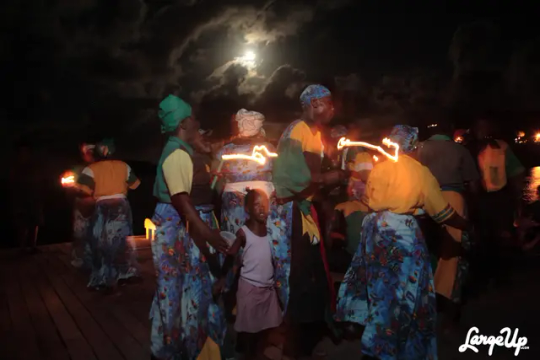
Kumina is an Afro-Jamaican religion. Kumina has practices that include secular ceremonies, dance and music that developed from the beliefs and traditions brought to the island by Kongo enslaved people and indentured labourers, from the Congo region of West Central Africa, during the post-emancipation era. It is mostly associated with the parish of St. Thomas in the east of the island. However, the practice spread to the parishes of Portland, St. Mary and St. Catherine, and the city of Kingston.

Kumina also gives it name to a drumming style, developed from the music that accompanied the spiritual ceremonies, that evolved in urban Kingston. The Kumina drumming style has a great influence on Rastafari music, especially the Nyabinghi drumming, and Jamaican popular music. Count Ossie was a notable pioneer of the drumming style in popular music and it continues to have a significant influence on contemporary genres such as reggae and dancehall.
The Kumina riddim is a dancehall riddim produced by Sly & Robbie in 2002. It has featured in recordings of over 20 artists including Chaka Demus & Pliers and Tanya Stephens.

Kumina is an Afro-Jamaican Religion and is not the same as Pukkumina or Pocomania.
Kumina emerged through the practices of indentured labourers who were brought to Jamaica from the Kongo region of central Africa after the abolition of slavery. In the second half of the 19th century it syncretised with Myalism. Kumina differed from Zion Revivalism in rejecting the belief that the Bible should be the central authority behind worship.
The practices of Kumina are primarily linked to healing.[4] Healing ceremonies utilise singing, dancing, drumming, animal sacrifice, and spirit possession, with the intent of summoning spirits to heal the sick individual. These elements are also found in Myalism and Zion Revivalism.
Organization of Kumina communities follows the general local character of African religions in Jamaica. Kumina communities are small family based communities or nations. Some nations include Mondongo, Moyenge, Machunde, Kongo, Igbo, and Yoruba. People from Kumina families are given the title Bongo. Marrying into a Bongo family is one avenue to become a part of a Kumina nation; special initiation is the other avenue. Kumina nations are led by a "King" and "Queen". Imogene "Queenie" Kennedy AKA Queenie III (c1920-1998) was a well-known Kumina Queen in the 20th century, born in St Thomas in the late 1920s she later moved to Kingston and then Waterloo, St Catherine.


The use of cannabis or ganja in Kumina may have been an influence on the adoption of this plant as a sacrament in Rastafari, a religion that developed in Jamaica during the 1930s.
#kumina#afro jamacian#jamaican#rastafari#african#afrakan#kemetic dreams#africans#brown skin#afrakans#african culture#afrakan spirituality#brownskin#rasta#rasta love#dancing rasta#rastaman#kisumi amau#impulsesv#tegan and sara#sexy nerd
5 notes
·
View notes
Text
SAINT OF THE DAY (January 4)

Saint Elizabeth Ann Seton was the foundress and first superior of the Sisters of Charity in the United States.
She was born to Episcopalian parents into New York City high society on 28 August 1774.
Her father, Dr. Richard Bayley, was the first professor of anatomy at Columbia College and praised for his work as the health officer of the Port of New York.
Her mother, Catherine Charlton, daughter of an Anglican minister of Staten Island, New York, died when Elizabeth was three years old, leaving her and two other young daughters.
Elizabeth was married on 25 January 1794 in St. Paul's Episcopalian Church to William Magee Seton.
When his father died, they took over custody of William's seven half brothers and sisters, as well as the family's importing business.
William fell into financial troubles. He later died of tuberculosis in December 1803 in Pisa, Italy, while attempting to get help from his business friends.
After getting to know the Catholic Church in Italy, Elizabeth fasted and prayed for light.
Finally, on Ash Wednesday, 14 March 1805, she was received into the Church.
Her conversion unleashed a storm among her Protestant relatives and friends, and made her financial strains even greater.
In January 1806, Cecilia Seton, Elizabeth's young sister-in-law, became very ill and begged to see the ostracized convert and told her of her desire to become a Catholic.
When Cecilia's decision was known, threats were made to have Mrs. Seton expelled from the state by the Legislature.
On her recovery, Cecilia fled to Elizabeth for refuge and was received into the Church.
Elizabeth moved to Baltimore in 1808, and with the help of a Catholic convert, a farm was purchased two miles from Mt. St. Mary's College.
Mrs. Seton took vows privately before Archbishop Carroll and her daughter Anna.
In 1810, Bishop Flaget was commissioned to obtain in France the rules of the Sisters of Charity of St. Vincent de Paul.
The rule, with some modifications, was approved by Archbishop Carroll in January 1812 and adopted.
Mrs. Seton was elected superior against her will and despite the fact that she also had to care of her children.
Many joined the community, including Mother Seton's daughter, Anna, who died during her novitiate (12 March 1812) but had been permitted to pronounce her vows on her deathbed.
Mother Seton and eighteen sisters made their vows on 19 July 1813.
The third time she was elected superior in 1819, she protested that it was the "election of the dead," but she lived for two years more, finally succuming to a pulmonary infection.
She died on 4 January 1821 in Emmitsburg, Maryland.
In 1880, Cardinal Gibbons (then Archbishop) urged the steps be taken toward her canonization.
She was beatified by Pope John XXIII on 17 March 1963. She was canonized by Pope Paul VI on 14 September 1975.
3 notes
·
View notes
Text
So, Death in Paradise. Hmm.
First off, what's up with the soundtrack of the astronomy bits? So gorgeous!!
Sophie, though, I have a problem. Not specifically with her because she's innocuous. But her role just doesn't work. It was the same with Martha. Who was also a down to earth blonde English woman on holiday who takes a shine to an eccentric detective. However, while two decent people fancying each other and going on a few dates might well be quite realistic, it's incredibly uncompelling TV. I had no investment in Martha and I have no investment in Sophie. She has no role in the show and on St Marie except as a love interest. If the detective is going to have a romance with a civilian (which does make sense) she at least needs to be built up and have some reason to care about her in the same way we care about Catherine.
There are many ways you could do it. Have her as a suspect in a case (2 parter episode to really build up tension and conflict of interest?). Have her be an expert brought in from another island to help with a case - also opens up a way for her to stay on the island. Have her work in some other capacity on the island, say opening a B&B and supported by Catherine so she has a life outside of being a love interest. None of these mean the detective couldn't leave to be with her if that was the direction it took but it could also allow her to become a fixture of the show independently.
Also, I find Sophie so far rather lazily written. She describes herself as a nerd but - as a nerd - she doesn't come across that way. She's very conventionally attractive and she dresses in a very normal way for a conventionally attractive woman. I'm not saying that's incompatible with nerdiness but I think if they want to go down the route of saying that Neville has found "someone like him" they should go all in. IDK - give her dyed hair, make her wear a nerdy t shirt and no make-up, make her queer, openly ND... It's just... so safe. And she just happens to be on holiday in the Caribbean totally on her own over Christmas. Again, it's not impossible but it's also a slightly odd thing to do for which so far no explanation is given for those choices. Probably because it's not important because she only exists to tick some boxes to meet Neville's specific needs - alone, nerdy (apparently), attractive... It's lazy and uninteresting writing.
#death in paradise#i don't mean to sound like i'm flaming her character#i'm just frustrated by the writing#it's so basic#i'd love to see neville have a really meaningful relationship but this isn't it#and i don't like to see female characters written so incoherently to fit a love interest role
24 notes
·
View notes
Text









Today in Great Lakes shipping history December 29th.
2022: Ice has been the name of the game across the lakes as of late, and the Twin Ports are certainly no exception. Great Lakes Towing’s Missouri and Heritage Marine’s Helen H. have been kept very busy over the past few days keeping traffic moving through the harbor, their red/green and yellow/brown paint schemes a nice contrast while assisting ships to and from their docks. Even with their help, however, it’s been tough sledding with the harbor coated in a thick ice sheet reportedly up to eight inches thick in some places. The impending warm(er) spell forecasted for the coming days will hopefully provide some relief until the season closes in just over two weeks.
Traffic on Tuesday, December 7 would begin out in the lake as John G. Munson got going from the anchorage at 06:00 heading up to Two Harbors. Over in Superior and within the confines of the port, American Integrity would get underway from BNSF shortly thereafter with a load of taconite bound for Conneaut. Her subsequent departure would be followed by a Michipicoten arrival at 06:47 after several days of sitting off the piers. Around 10:45, Arthur M. Anderson finally steamed up, up, and away from CN Dock 6 after what has been a long stay for her in port as well. The journey from West Duluth to the Aerial Lift Bridge typically takes a little over 45 minutes in the summer; due to ice, however, the steamer and tug Helen H. would struggle for over two hours before Anderson cleared for Gary at 13:03. Joyce L. VanEnkevort/Great Lakes Trader came in from anchor to take over at CN 6, appearing in dire need of a shave with a thick beard of ice.
As of Wednesday morning, there were at least 13 ocean-going vessels left to pass through the St-Lambert Lock by January 1, the new official date of the closure of the St. Lawrence Seaway. They are Federal Alster, Federal Bering, Federal Dart, Federal Dee, Federal Hudson, Federal Kushiro, Federal Seto, Isadora, Jamno, Scot Bremen, Strandja, Taagborg and Tufty.
It seems (though unconfirmed) that the Thunder Bay, which arrived Tuesday night at Côte Ste-Catherine, will spend the winter there.
365 days a year, the Great Lakes are a gateway for commerce and travel, a feat that wouldn’t be possible without the U.S. Coast Guard’s fleet of icebreakers.
That work is accomplished through Operation Taconite, the only domestic icebreaking mission in the United States. Set forth by an executive order issued in 1936, the operation encompasses all the Great Lakes, St. Marys River, the Straits of Mackinac and Georgian Bay. The goal is to protect the environment, safeguard island communities and meet the reasonable demands of commerce.
Assisting ships, rescue missions and track-making are all in the job description for icebreakers. The crew and vessels put in roughly 5,000 employment hours from December to April.
Boat Nerd
#freighter#shipping#ore boat#tug boat#maritime#nautical#ice breaker#great lakes#salties#edmund fitzgerald#harbor#port#ice
28 notes
·
View notes
Text
ok dip queer related headcanons bc im tired of doing all the gay work around here and i need my delusions to be recognized
NEVILLE
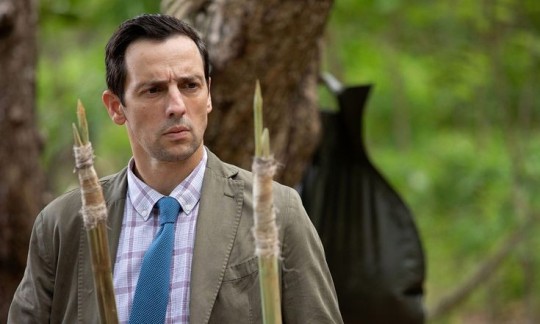
first off i like to think of him as gay and not bi, bc sure he had a crush on florence and an evil gf but like i, too, pretended i had a crush on florence bc she’s gorgeous but i just liked her like i liked lady gaga (and for the evil gf part..... idk it just makes sense)
but he could be bi!!! i don’t have anything against it i just hc him as gay
is used to being made fun of for his allergies and very autistic traits and thought for decades that his homosexuality was just the same weird ol stuff, something that society tolerates as long as he finds a way to hide it
catherine somehow ends up telling him about it and he denies it until she puts him straight in front of the facts
doesn’t want to admit it bc f*ck no he already has too many personal issues
hopeless romantic, once he gets over it
thinks it would be easier to flirt with men bc he is truly attracted to them but he is EVEN MORE OF A MESS if it’s even possible
CATHERINE

she is 10000% a pure ally she LOVES queer ppl
i don’t think she’s queer herself tho??? there’s a good chance she tried it but i think she just loves men too much
she watches drag race and her favorites are the weird queens, try changing my mind on this one JUST TRY
she helps organize the st-marie pride parade every year and gives water bottles and hugs to every kid she can get her hands on (with consent of course)
a huge mother figure for all queer kids on the island (maybe i am projecting a bit on this one but like. am i wrong?)
MARLON

at first he was one of the bros so he wasn’t really open to it :/
it went away!! i like to think he also got a trans gf at some point
definitely straight but an ally!
wants to show supports but has no idea how (example: going up to a lesbian and saying stuff like "so like.... women amirite?? what do u like in women? personally i looove their hips")
not into politics but if a queer friend tells him to search information on something he will do it 100% no questions asked if it can make them more comfortable
NAOMI

wlw she/they queen
aren’t all naomi’s she/they queens anyway
very calm but will absolutely riot if necessary
maybe a lesbian?? i haven’t yet decided (and idk if she has a canon bf in the series i don’t remember)
FLORENCE

bisexual and i’m not sorry
has only dated men her whole life and is TIRED
loves to educate those around her but wishes people would LEARN by themselves instead sometimes (was probably annoyed by marlon at some point)
has a whole other queer life back in paris
DWAYNE

i feel like he is bi-curious like rn he likes women but u know i don’t think he necessarily shyed away from novelty back in his 20s
by novelty of course i mean men
i don’t. i don’t have much else to add lol im just gay and have daddy issues so like....... yeah
this is it for now, i don’t know the other characters as much as i do them but maybe i’ll do others!!
#death in paradise#dip#queer headcanons#mine#i feel SO WEIRD for doing that omg#like booooh look at that gay loser#trying to justify his rarepair by desperately sticking queer hc’s on a low-quality absolutely straight show#i feel delusional#but oh well don’t we all amirite#anyway sorry friends
11 notes
·
View notes
Text
I haven't posted an update in a while, should I be documenting more?
Recently finished:
🇱🇨 St. Lucia - 'Til I Find You, Greta Bondieumaitre
🇦🇺 Australia - Ghost Bird, Lisa Fuller
Currently reading:
🇸🇹 São Tomé & Príncipe - The Exiles of Crocodile Island, Henye Meyer
🇸🇳 Senegal - No Heaven for Good Boys, Keisha Bush
🇦🇺 Australia - The Things She's Seen, Ambelin & Ezekiel Kwaymullina
🇩🇰 Denmark - The Shamer's Daughter, Lene Kaaberbøl
Up Next:
🇳🇵 Nepal - What Elephants Know, Eric Dinerstein
🇾🇪 Yemen - When a Bulbul Sings, Hawaa Ayoub
🇲🇹 Malta - The Maltese Dreamer, Catherine Veritas
I'm probably going to drop The Shamer's Daughter for various reasons - I can't do that many audiobooks at once, plus I had wanted to read Nothing by Janne Teller for Denmark anyway.
#updates#currently reading#diverse books#booklr#books and reading#ya world challenge#st lucia#australia#sao tome and principe#senegal#denmark#nepal#yemen#malta
6 notes
·
View notes
Text
Sains&Reading: Tuesday, August 22, 2023
august 9_august 22
St ALEXIS MEDVEDKOV ARCHPRIEST OF UGINE (France_1934)
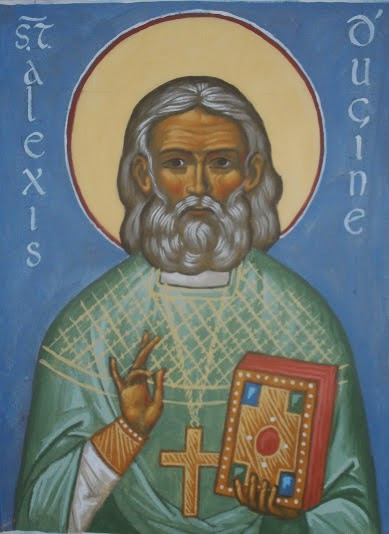
Alexei Ivanovich Medvedkov was born on 1 July 1867 into the family of the young Fr John Medvedkov, in the village of Fomichevo near Viazma. The latter passed away soon after his son's birth and the little Alexis began a life full of privations and poverty and the usual path for a priest's son: church school and seminary, which he finished in 1889. Then came the problems of obtaining a post, giving him and his widowed mother some sort of security. Despite the views of his friends, the good conscience of the young man did not allow him to take up the difficult task of the priesthood at once, for he considered himself unworthy. First of all, he decided to test himself and prepare for the priesthood as a church reader and singer. With his fine bass voice, he obtained a position as choir director in St Catherine's church on Vasilevsky Island in St Petersburg. Here he married.
After some five years spent here, Alexis went to the future St John of Kronstadt to whom he had sometimes confessed. Seeing this God-fearing man, Fr John blessed Alexis to serve as a parish priest. In December 1895 (old style) he was duly ordained deacon and two days later, priest, by Metropolitan Palladius of St Petersburg. The new priest was assigned to a poor parish in the village of Vruda in the Yamburg region of the province of St Petersburg, sixty miles from the city. Here Fr Alexis was to spend twenty-three years of his life.
Fr Alexis was loved by the 1500 peasant-parishioners in his church, built in 1840 and dedicated to the Dormition, and also by the children in the local schools and in the orphanage. His widowed mother Leonilla came to live with her son and baked prosphora for the parish. Two children, both daughters, were born to him. He would knock at every door, encouraging people to practise their faith; he would spend whole nights collecting materials for his sermons, he ordered books and read the Holy Fathers in his desire to feed his flock. And yet this was such a poor parish that the priest was himself obliged to work the land, plough and harvest, like his parishioners, in order to survive. Fr Alexis won the respect of his brother-priests. The church authorities recognised his zeal, humility and compassion, giving him several awards and in 1916 making him archpriest.
In 1917, then aged fifty, Fr Alexis was one of the first to be arrested by the Bolsheviks for his steadfast faith and then thrown into prison. Here he was tortured, his arms and legs broken, a nerve in his face torn and finally he was scourged and sentenced to death. However, extraordinarily, his eldest daughter gave herself up as a hostage and the ageing priest was released. The trace of these events remained on Fr Alexis' face for the rest of his life; he lost the use of a facial nerve and his right eye was always open wider than his left.
In 1919, however, the whole family managed to escape to Estonia where they lived at a place called Kochtla-Iarve. The life of a refugee and the lot of exile in Estonia were bitter. In order to feed his family Fr Alexis undertook hard physical work in a slate mine alongside Estonian criminals in their shackles. Now in his fifties, Fr Alexis found the work exhausting. He was given a surface job and finally that of night-watchman. In 1923 the Church authorities in Estonia attached him to a parish as an assistant priest. Serving the liturgy every Sunday, helping in the parish school and living in great poverty and exhaustion, in 1926 his matushka fell seriously ill. In 1929 came the next trial: matushka died, leaving Fr Alexis a widower.
On the loss of his matushka, Fr Alexis petitioned Metropolitan Eulogius of the Constantinople Russian jurisdiction in Paris, asking to join his diocese in France. Finally, after many trials, in 1930 Fr Alexis arrived in France with his two daughters and a grandson. Here he was appointed rector of the St Nicholas Russian Orthodox church at Ugine near Grenoble in the French Alps. Here was a parish dependent on a local metallurgical factory set in the pine-clad mountains from which streamed the water to power its turbines. This factory employed some 600 Russian immigrant workers, mainly recruited in Estonia and the Balkans. The factory management had given the workers a large wooden workshop, which by 1927 they had turned into a church and had consecrated.
Although materially Fr Alexis' life was now better, he still looked like a typical Russian country priest, with an old, worn-out cassock and indeed, an old, worn-out face. However, he proved to be a man of prayer who paid great attention to the way in which the services were celebrated. He often celebrated on weekdays and the Sunday liturgy was very solemn, served with heartfelt faith. In this he was aided by the devotion of the choir which sang very well. Fr Alexis would arrive very early at church and pray for a long time. During the liturgy he intoned every word very clearly, made no omissions and often preached, his sermons being well-constructed and lengthy. After the service, Fr Alexis would stay on to pray, doing memorial services and other services for the parishioners, never taking money.
Although his material situation was much better, morally the Lord sent him new trials. His new flock, mainly composed of factory-workers, did not appreciate him, failing to understand his humility and truly Christian compassion. He would always strive to be on good terms with everyone and would not take sides in disputes. When insulted, he would reply with humble silence, he listened rather than spoke. If the conversation became political or was offensive to others. he would grow silent and begin to pray. With close friends, however, he showed his erudition and became talkative with regard to God and the Church. He frequently quoted the Gospels, and the Psalms, which he knew by heart, and also quoted the Church Fathers. He especially appreciated the Russian theologian, Khomyakov. He was well-read in literature and science too and he was particularly gifted with children whom he taught at the church school.
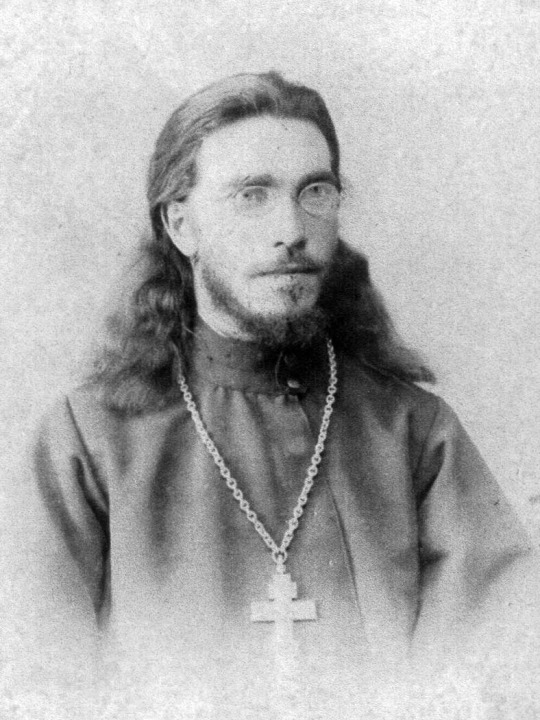
His parishioners remembered him as an honest, exceptionally modest man, rather delicate even shy, always thanking God, even in his great need. He was often engrossed in prayer, silent but also friendly, showing a prayerful humility and patient compassion, refusing to criticise. Since Fr Alexis used to give away much of what he received, his life in Ugine was still materially poor. Fr Alexis also found it difficult to adapt to the new conditions of politicised exiles. Unfortunately, his own children did not share his great faith. In the parish there were enemies. Some parishioners disliked his long services, others slandered him for his poor dress. Complaints were made to his Metropolitan in Paris. The parish council turned out to be particularly difficult, as it was dominated by secular-minded laypeople of a military background, used to giving orders. Their main interest was not the Church, but politics. Different cliques tried to drag Fr Alexis onto their side. Fr Alexis would not reply to them, remaining engrossed in silent prayer. He always defended the rules of the Church, on this making no concessions, and never taking part in politics.
Some parishioners actually began to harass Fr Alexis during the services. Finally, a group of parishioners denounced Fr Alexis to his Metropolitan who summoned him to Paris. Realising that the gentle and meek Fr Alexis was incapable of defending himself, another group of parishioners, almost four times more numerous, took his defence. Trembling with emotion, Fr Alexis went to Paris, where the Metropolitan also defended him. A new parish council was appointed, but Fr Alexis was not to remain in this world for much longer.
His health had been undermined not only by the tribulations of the Communists, but also by a horrible illness. Cancer of the intestine was diagnosed and Fr Alexis was confined to bed. In July 1934, Fr Alexis was taken to hospital in Annecy in Upper Savoy. Here, one of his most faithful parishioners came to see the lonely pastor and Fr Alexis confided in him. He told him how much he liked akathists and canons and then said the akathist to St Panteleimon, whom he particularly loved. He also said how much he liked children:
'In my parish the true parishioners are the children, the children of my parishioners…and if those children live and grow up, they will form the inner Church. And we too, we belong to that Church, as long as we live according to our conscience and fulfil the commandments…do you understand what I mean? In the visible Church there is an invisible Church, a secret Church. In it are found the humble who live by grace and walk in the will of God. They can be found in every parish and every jurisdiction. The emigration lives through them and by the grace of God'.
The last days of the earthly life of Fr Alexis were coming and he foreknew his death. Indeed, an operation brought no relief. In August 1934 more parishioners came to see him. He encouraged them all to live a Christian life, asking them to pray and fast. Fr Alexis suffered greatly; he knew that he was going to die. He never complained and his mind remained clear. Fearing sudden death, he called the nearest priest, belonging to the Church Outside Russia. Later his confessor came. In their absence he asked forgiveness of everyone, especially those who had once persecuted him, and blessed everyone. He prayed and wept, begging the grace of God. The day before he died, Fr Alexis received confession, unction and communion. His neighbours in the hospital ward related how on the eve of his death he sang church hymns and early in the morning humbly and peacefully went to the Lord. It was 22 August 1934.
After his death the doctors disclosed that Fr Alexis cancer was malignant, it had spread throughout his body. They demanded that he placed in a coffin immediately, for in the case of malignant cancer the body would decompose very rapidly.
All the Russians in Ugine, regardless of their jurisdiction, attended his funeral. This included those who had once denounced him. The funeral was marked by the cross, the banners, the Paschal vestments, the children holding flowers and dressed in white, the choir singing wonderfully, the coffin draped in white, the crowds of people. The solemn but joyful mood dissolved the sorrow of a dear loss. Everybody, even Fr Alexis' eldest daughter, weeping inconsolably, finished by calming down. Walking up to the hilltop cemetery, everybody felt that the soul of the dear, beloved pastor had departed not to the dark of the tomb but to the heavenly mansions of the Lord.
Fr Alexis was buried in the first available grave space, but then the new rector bought a concession for thirty years in another part of the cemetery with money he had collected from parishioners. This was to be the first transfer of Fr Alexis' body, during which the coffin lay on the surface for three days.
After the Second World War the Russian Orthodox parish in Ugine transferred its jurisdictional allegiance from Constantinople to the Russian Patriarchal Church. In 1953 Ugine town council decided to build flats on the site of the old cemetery and open a new cemetery, where, in the coming years, families would be able to transfer the remains of their loved ones. Parishioners decided that it would be too expensive to pay for the reburial of Fr Alexis. However, the parish priest, Fr Philip Shportak, borrowed some money which he agreed to pay back in monthly instalments, and arranged to pay for the transfer out of his own pocket. On 22 August 1956, exactly twenty-two years to the day after Fr Alexis had passed away, council workmen came to Fr Alexis' grave.
For the last three years they had been working with shovels and pickaxes, collecting bones, placing them in small coffins and moving them to the new cemetery. Now they were at Fr Alexis' grave, expecting to pick up his bones too. Having dug down exactly four feet, the first wonder took place. 'An unknown force' (as they later related) impelled them to throw their tools away and begin digging with their hands. This turned out to be a miracle, for stupefied, they soon uncovered the body of the priest, who looked as though he had been buried only two or three days before.
He bore not the slightest mark; his face and hands looked as though they were made of wax. And yet the wood and metal of his coffin had totally disintegrated. Although the body had been in contact with the wet soil, yet both the body and the vestments with their white brocade and golden crosses, as well as the Book of Gospels on his chest, were intact. Only the metal binding of the Gospels had darkened with age. The workmen tested the material of the vestments, trying to tear it, but they could not. And yet here was the body, full of malignant cancer, which had died exactly twenty-two years before and which the doctors had said would decompose immediately.
The new coffin prepared for the removal of the remains was too small, for it was supposed to take only bones. Therefore the workmen had to cross the priest's arms over his chest and raise his knees. They discovered that the joints were very supple, like those of a living man. The whole body smelled fresh. The cemetery keeper, also a gravedigger, declared that in thirty years of career, during which he had frequently had to open graves, he had never seen anything like it. A doctor was called. He was amazed by what he saw and stated that the body of someone with a malignant cancer had never failed to decompose. 'It is a real miracle', he said. As they lifted the body from the grave, everybody thought that it would disintegrate. But this did not happen. The body remained quite intact.
For three whole days during the August heatwave, the small coffin containing the body lay on the surface. During that time it was opened on several occasions, since visitors, both Russians and French, came to see this phenomenon. Unbelievers thought that the body would start to decompose on contact with the air. But this did not happen. When the day came for the reburial in the new cemetery, it was raining. In fact it poured so hard that the workmen and others simply lowered the coffin into the new grave and then ran for cover, leaving the grave open and the faithful Fr Philip to do the funeral service in the driving rain.
Before the new grave was filled in, many came to look, especially Poles, Italians and French. Believers knelt and prayed. Unbelievers shrugged their shoulders in astonishment. At the request of Fr Philip, Metropolitan Nicholas of the Patriarchal Church came and celebrated a memorial service over the grave. Fr Paul Pukhalsky, a priest of the Paris Jurisdiction of Russians, came, spoke to eyewitnesses and then made a report to his Metropolitan, Vladimir. The priest suggested that the body be removed to the Russian cemetery church of the Dormition at Sainte-Genevieve-des-Bois near Paris. The Metropolitan enthusiastically agreed and a date for the transfer was fixed: 3 October 1957.
On 30 September 1957, workmen preparing for this transfer, not openly opened the grave, but also, and without permission, once more opened the coffin. They and other eyewitnesses were startled to see that the body was still incorrupt, having suffered no change whatsoever. On the day of the transfer after a graveside memorial service, the coffin, inserted into a second zinc-lined coffin, was taken to the church in Ugine. Here another memorial service took place. Although it was a weekday, the factory had gone on strike, enabling a great many people to attend that service. The body arrived at Sainte-Genevieve-des-Bois, 500 miles away, in the evening of the same day, Thursday 3 October 1957. A man reported to one of the priests present that two people had already been miraculously cured of serious illnesses through the prayers of Fr Alexis. The relics were placed in the crypt of the church and a service was celebrated.
The next day, Bishop Methodius of the Paris Jurisdiction celebrated a liturgy in the church. This was followed by a memorial service at which representatives of the two other Russian Orthodox jurisdictions, ROCOR and the Patriarchal Church, concelebrated. Those disunited were thus united. In a sermon Fr Philip Shportak, said: 'Through the incorruptibility of His good shepherd, the Lord is calling all of us to remain faithful children of the Orthodox Church'. To this day the relics of Fr Alexis remain there and the faithful children of the Orthodox Church come to pray before them


ACTS 1:12-17, 21-26
12 Then they returned to Jerusalem from the mount called Olivet, which is near Jerusalem, a Sabbath day's journey. 13 And when they had entered, they went up into the upper room where they were staying: Peter, James, John, and Andrew; Philip and Thomas; Bartholomew and Matthew; James the son of Alphaeus and Simon the Zealot; and Judas the son of James. 14 These all continued with one accord in prayer and supplication, with the women and Mary the mother of Jesus, and with His brothers. 15 And in those days Peter stood up in the midst of the disciples (altogether the number of names was about a hundred and twenty), and said, 16 Men and brethren, this Scripture had to be fulfilled, which the Holy Spirit spoke before by the mouth of David concerning Judas, who became a guide to those who arrested Jesus; 17 for he was numbered with us and obtained a part in this ministry. 21 Therefore, of these men who have accompanied us all the time that the Lord Jesus went in and out among us, 22 beginning from the baptism of John to that day when He was taken up from us, one of these must become a witness with us of His resurrection. 23 And they proposed two: Joseph called Barsabas, who was surnamed Justus, and Matthias. 24 And they prayed and said, "You, O Lord, who know the hearts of all, show which of these two You have chosen 25 to take part in this ministry and apostleship from which Judas by transgression fell, that he might go to his own place.
LUKE 9:1-6
1 Then He called His twelve disciples together and gave them power and authority over all demons and to cure diseases. 2 He sent them to preach the kingdom of God and to heal the sick. 3 And He said to them, "Take nothing for the journey, neither staffs nor bag nor bread nor money; and do not have two tunics apiece. 4 Whatever house you enter, stay there, and from there depart. 5 And whoever will not receive you, when you leave that city, shake off the very dust from your feet as a testimony against them. 6 So they departed and went through the towns, preaching the gospel and healing everywhere.
#orthodoxy#originofchristianity#easternorthodoxchurch#spirituality#holyscriptures#bible#gospel#wisdom#saints
3 notes
·
View notes
Text
Who is the worst founding father?
Round 3: Button Gwinnett vs Alexander Hamilton
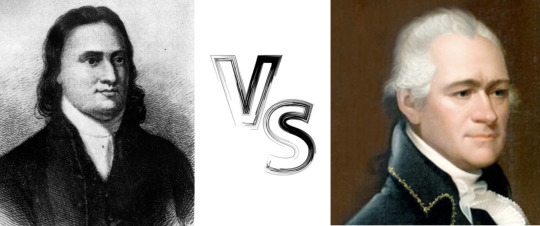
Button Gwinnett (March 3, 1735 – May 19, 1777) was a British-born American Founding Father who, as a representative of Georgia to the Continental Congress, was one of the signers (first signature on the left) of the United States Declaration of Independence. Gwinnett was killed in a duel by rival Lachlan McIntosh following a dispute after a failed invasion of East Florida.
Gwinnett’s business activities took him from Newfoundland to Jamaica. Never very successful, he moved to Savannah, Georgia in 1765, and opened a store. When that venture failed, he bought (on credit) St. Catherine’s Island, as well as a large number of enslaved people, in order to attempt to become a planter. Though his planting activities were also unsuccessful, he did make a name for himself in local politics and was elected to the Provincial Assembly.
During his service in the Continental Congress, Gwinnett was a candidate for a brigadier general position to lead the 1st Regiment in the Continental Army but lost out to McIntosh. The loss of the position to his rival embittered Gwinnett greatly.
He became Speaker of the Georgia Assembly, a position he held until the death of the President (Governor) of Georgia Archibald Bulloch. Gwinnett was elevated to the vacated position by the Assembly’s Executive Council. In this position, he sought to undermine the leadership of McIntosh. Tensions between Gwinnett and McIntosh reached a boiling point when the General Assembly voted to approve Gwinnett’s attack on British Florida in April 1777.
Gwinnett had McIntosh’s brother arrested and charged with treason. He also ordered McIntosh to lead an invasion of British-controlled East Florida, which failed. Gwinnett and McIntosh blamed each other for the defeat, and McIntosh publicly called Gwinnett “a scoundrel and lying rascal”. Gwinnett then challenged McIntosh to a duel, which they fought on May 16, 1777. The two men exchanged pistol shots at twelve paces, and both were wounded. Gwinnett died of his wounds on May 19, 1777. McIntosh, although wounded, recovered and went on to live until 1806.
Alexander Hamilton (January 11, 1755 or 1757 – July 12, 1804) was a Nevisian-born American military officer, statesman, and Founding Father who served as the first United States secretary of the treasury from 1789 to 1795.
On February 15, 1781, while working as Washington’s chief of staff, Hamilton was reprimanded by Washington after a minor misunderstanding. Although Washington quickly tried to mend their relationship, Hamilton insisted on leaving his staff. He officially left in March, and settled with his new wife Elizabeth Schuyler close to Washington’s headquarters. He continued to repeatedly ask Washington and others for a field command. Washington continued to demur, citing the need to appoint men of higher rank. This continued until early July 1781, when Hamilton submitted a letter to Washington with his commission enclosed, “thus tacitly threatening to resign if he didn’t get his desired command.”
In 1784, Hamilton founded the Bank of New York.
Early during the Constitutional Convention Hamilton made a speech proposing a President-for-Life; it had no effect upon the deliberations of the convention. He proposed to have an elected president and elected senators who would serve for life, contingent upon “good behavior” and subject to removal for corruption or abuse; this idea contributed later to the hostile view of Hamilton as a monarchist sympathizer, held by James Madison.
During the Revolutionary War, affluent citizens had invested in bonds, and war veterans had been paid with promissory notes and IOUs that plummeted in price during the Confederation. In response, the war veterans sold the securities to speculators for as little as fifteen to twenty cents on the dollar. Hamilton felt the money from the bonds should not go to the soldiers who had shown little faith in the country’s future, but the speculators that had bought the bonds from the soldiers.
Strong opposition to Hamilton’s whiskey tax by cottage producers in remote, rural regions erupted into the Whiskey Rebellion in 1794; in Western Pennsylvania and western Virginia, whiskey was the basic export product and was fundamental to the local economy. In response to the rebellion, believing compliance with the laws was vital to the establishment of federal authority, Hamilton accompanied to the rebellion’s site President Washington, General Henry “Light Horse Harry” Lee, and more federal troops than were ever assembled in one place during the Revolution. This overwhelming display of force intimidated the leaders of the insurrection, ending the rebellion virtually without bloodshed.
During the election of 1796, Hamilton urged all the northern electors to vote for Adams and Pinckney, lest Jefferson get in; but he cooperated with Edward Rutledge to have South Carolina’s electors vote for Jefferson and Pinckney. If all this worked, Pinckney would have more votes than Adams, Pinckney would become president, and Adams would remain vice president, but it did not work. The Federalists found out about it and northern Federalists voted for Adams but not for Pinckney, in sufficient numbers that Pinckney came in third and Jefferson became vice president.
In the summer of 1797, Hamilton became the first major American politician publicly involved in a sex scandal. After engaging in an affair with 23-year-old Maria Reynolds, Hamilton was blackmailed by Reynolds’s husband and ended up paying over $1300 in payments to him. After being arrested for counterfeiting and speculating, James Reynolds implied he had evidence of illegal activity by Hamilton during his time as Treasury Secretary. Threatened by attacks against his integrity as a public servant that claimed his business with James Reynolds had to with improper speculation, Hamilton published a 100-page booklet, later usually referred to as the Reynolds Pamphlet, and discussed the affair in indelicate detail for the time.
Hamilton served as inspector general of the United States Army from July 18, 1798, to June 15, 1800. If full-scale war broke out with France, Hamilton argued that the army should conquer the North American colonies of France’s ally, Spain, bordering the United States.
To fund this army, Hamilton urged passage of a direct tax. The eventual program included taxes on land, houses, and slaves, calculated at different rates in different states and requiring assessment of houses, and a stamp act like that of the British before the Revolution, though this time Americans were taxing themselves through their own representatives.
Hamilton is not known to have ever owned slaves, although members of his family were slave owners. At the time of her death, Hamilton’s mother owned two slaves and wrote a will leaving them to her sons. However, due to their illegitimacy, Hamilton and his brother were held ineligible to inherit her property and never took ownership of the slaves. He occasionally handled slave transactions as the legal representative of his own family members.
#founding father bracket#worst founding father#founding fathers#amrev#brackets#polls#button gwinnett#alexander hamilton
11 notes
·
View notes
Text
Thursday 5 September 1839
7
10 50/..
Good comfortable night in our spacious airy bedroom – doing and repacking portmanteau etc. till about 9 – then had Gross – breakfast 10 ¼ the Russian steamer arrived from St. P- at 5 this morning – F69 ½° now at 9 50/.. breakfast at 10 ¼ - ticketing minerals etc. till now 11 ¾ - calèche (neat carriage) and out at near 12 – to the Russian steamer – good accommodation but the Captain in bad English talking of rough water – A- frightened – did not them engage the places – well they be gone tomorrow? then to the bank or counting house (merchants not bankers) of Messrs. Tottie and Aufwedson [Arfvedson] – young man who speaks good English very civil – exchanged 2 circulars nos. 8586 and 8587 = £50
8586
8587
8588
paid 2 rigs dollars
Palace about 1 first musée pictures and statues and then the old wardrobe of royal cloths – could not see the royal apartments – nor the library – then to the park – paid 6sk. banco on entering – at the Kings’ petite chateau at 4 – Sumach, red dogwood, and ditto with red berries – Spiraea calcifolia [salicifolia]– several pretty sorts of ragwort and scarlet Lychnus [Lychnis] and Michaelams china asters marigolds dahlias – sumach headed down to about a yard from the ground had made shoots above a yard long this year – oaks small and tall planted this spring and headed down to about 2 yards long – much narrow leaved willow pretty – double chamomile – much lilac cut down short, and shrub-wise – oat-sheaves stuck tall small poles to dry as in Norway etc. – much Norway maple here and everywhere – its autumnal scarlet beautiful – much birch too – a moss on the fine large old oaks here as yellow (ochre) as the red (rud) moss on the stones in the forests about our own journey from Upsala [Uppsala] – noticed this yellow moss 1st time today – and saw a little of red in the forests near Stockholm on our return –
SH:7/ML/TR/13/0024
September Thursday 5 – at the mint (collège des mines) at 4 – i.e. 4 ¾ by my watch – plan (model of) the gold mine at Adelfors [Ädelfors] on a little island on the wetter lake –
métallurgie pratique du fer......... par Walter de St. Ange avec atlas – Paris Libraire Scientifique et industrielle du L. Mathiers (Augustin) Quai Malaquais no. 15 1835-8 4to.
the Captain of the Russian Steamer Furst Menschicoff said this morning that the exchange was 41 skillings rigs. for one paper rouble
41 sk. rigs = 27 2/3 sk. banco say 28sk. banco = 1 paper rouble
banco 11.30.0 = £1
11.30x48 = 550/28 = 10 18/28
then say nineteen thirds of a sk. banco = 6 sk. banco and say one has at this rate 20 roubles for £1 then the loss per £1 = 1/6 or ¾ English or about 16 ½ p.c. terrible!
¾ hour at the mint for nothing but to give the garçon a rigs. dollar – he knew nothing – not even whether the professor of mineralogy was in town or not – very few specimens ticketed – most of them locked up and we no better for sauntering along the 3 or 4 rooms – home at 5 ¾ - heated up in our little boiler the rest of our yesterdays’ lamb (very good) and had bad coffee – out (in the carriage) again at 7 to 8 ½ - the King dined today with the Russian minster Comte [Mastuzevre] on board the Russian steamer that brought him here – the vessel all decorated with steamers as we passed – that we missed seeing thinking he was returned as we came back – had Grotza – F66° at 9 50/.. pm. very fine – the fine view Jean has persuaded us to go to see even so late from Moses’ mountain turned out to be the hill-café near St. Catherines’ church that William Riddle our Götheborg [Gothenburg] coach man took us to see – glad to see it again even by twilight – very beautiful – and our former knowledge restored what the lateness of the hour (7 1/4)........obscured – then drove about the principal to the large hotel now building began Jean says this spring – the site in the time of Gustaf 1 a large hill of gravel and sand from which he bombarded the castle
taken away to fill up with about the new bridge and up to the pretty double flight of stairs and the lions – all that used to be water
2 notes
·
View notes
Text
Separatist and irredentist movements in the world
San Andrés y Providencia
Proposed state: San Andrés y Providencia
Region: Archipelago of San Andrés, Providencia and Santa Catalina, Colombia
Ethnic group: Raizals
Goal: independence
Date: 1960s
Political parties: -
Militant organizations/advocacy groups: Archipelago Movement For Ethnic Native Self Determination
Current status: active
History
1510 - Spain claims the archipelago
1630 - arrival of English Puritans
1641 - Portuguese and Spanish conquest
1670-1672 - English buccaneer invasion
1775 - resettlement of the islands
1818 - French conquest
1822 - the islands join Gran Colombia
1903 - the population rejects separation from Colombia
1999 - formation of the Archipelago Movement for Ethnic Native Self-Determination
2001-2012 - ICJ procedure over disputed claim
2002 - declaration of self-determination
2007 - independence declaration
2012 - an independence referendum is proposed
Spain claimed the Archipelago of San Andrés, Providence and Santa Catalina in 1510 and placed it under the administration of the Captaincy General of Guatemala. English Puritans arrived in Providencia in 1630, but the colony was soon conquered by the Portuguese and Spanish. In 1670, English buccaneers took over the islands but abandoned them two years later.
The islands were only repopulated in 1775 when they were transferred to the Viceroyalty of New Granada. In 1818, the French captured Providencia and St. Catherine. After the islands obtained independence, they voluntarily joined Gran Colombia. They rejected a U.S. offer to separate from Colombia in 1903.
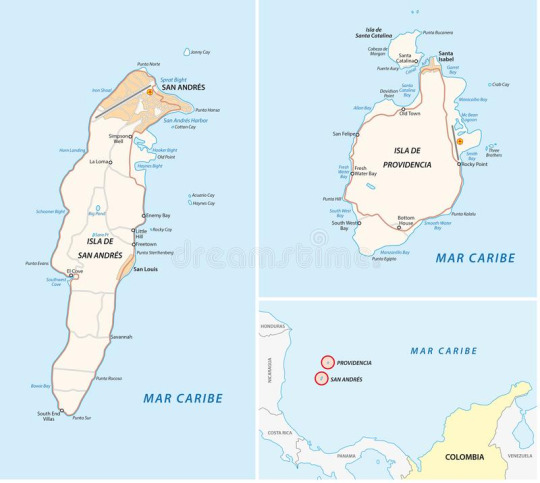
Separatist movements started to spring up in the 1960s and sent a memorandum to the United Nations. In 2007, the Raizal people proclaimed their independence and proposed the celebration of a referendum five years later.
In 2001, Nicaragua filed a claim with the International Court of Justice over its maritime borders with Colombia, including the archipelago. The Court ruled that Colombia had sovereignty.
Raizal people
There are around 30,500 Raizal. They live in Nicaragua and the archipelago, where they represent 57% of the population. The Raizal people are one of the recognized Afro-Colombian ethnic groups.

Their native language is San Andrés-Providencia Creole, but they also speak English and Spanish. The main religion is Christianity, both Catholicism and Protestantism.
Vocabulary
Archipiélago de San Andrés, Providencia y Santa Catalina - Archipelago of San Andrés, Providencia and Santa Catalina
Criollo sanandresano - San Andrés-Providencia Creole
Movimiento por la Autodeterminación de los Nativos del Archipiélago - Archipelago Movement for Ethnic Native Self-Determination
4 notes
·
View notes
